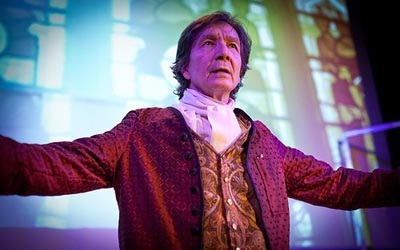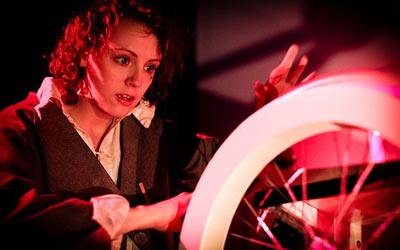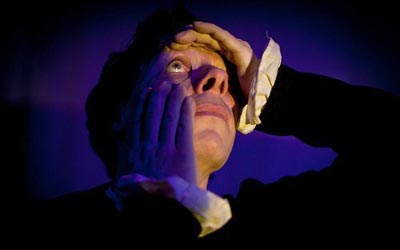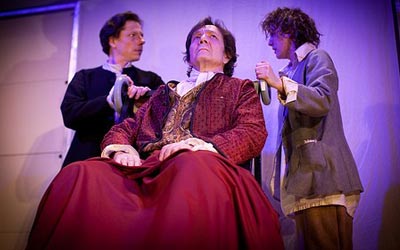Let Newton Be!
Craig Baxter
28 March 2011
The Royal Society, London
Putting Isaac Newton on stage is a tricky task. More than any other member of the physics pantheon, the father of gravitation was a difficult, unpleasant man. He had few friends, none of them close, and no family life to speak of. Most of his writing deals with religion or alchemy, not science, and even his major scientific works are frequently couched in abstruse language (try reading the Principia sometime). And for what it’s worth, Newton would have hated being in a play: he never attended the theatre, and his only recorded visit to the opera ended when he ran away during the third act.
In Let Newton Be! the playwright Craig Baxter brilliantly evades most of these pitfalls. Newton was antisocial by nature, for example, but drama requires that he have someone to talk to onstage. Baxter’s ingenious solution is to populate his play with three different versions of Newton: Isack, a bookish young misfit; Newton, an ambitious, untidy scholar; and Sir Isaac, an elder statesman who takes equal pleasure in prosecuting counterfeiters and persecuting rivals. These three versions of Newton interact throughout the play – contradicting, arguing and agreeing with each other in turn.
As the play opens, all three Newtons are struggling to understand the motion of three objects under mutual gravitational attraction. Or maybe they are struggling with the idea of the Holy Trinity. Initially, it is hard to tell the difference. This is partly deliberate: Let Newton Be! was commissioned by the Cambridge-based Faraday Institute for Science and Religion, and the links between Newton’s scientific work and his religious views are a major theme.
Newton speaks for himself
However, some confusion also stems from the dialogue itself, which Baxter has drawn from the writing of Newton and his contemporaries. On balance, the decision to use Newton’s own words is a good one. The play’s title is taken from Alexander Pope’s famous epitaph (“Nature and nature’s laws lay hid in night; God said ‘Let Newton be’ and all was light”), but so much has been written about Newton that it could almost be a plea – let the man speak for himself!
Still, there are challenges in crafting a play from Newton’s original words. Newton was many things, but a great communicator he was not. Following his ideas in their raw form is a difficult task, especially since the audience must also adapt to the unfamiliar cadence and terminology of 17th century written English. Worse, Newton was famously humourless: his letters are not witty, and he reportedly laughed only once in his entire life. Finally, despite the remarkable quantity of Newtonalia – some four million words of his published and private writing survive – there are some gaps in his life, notably his mysterious breakdown in 1693.
Part of the solution to these challenges comes from Baxter, who occasionally puts the words of early Newton biographers into the mouth of Sir Isaac, allowing him to narrate and comment on various events. The remainder is up to the director, Patrick Morris, and the three actors playing Newton, who must supply the humour and understanding that the original did not.
In the performance I saw at the Royal Society in London on 28 March, they did this with great aplomb. Kate Malyon as the young Isack and William Finkenrath as Newton poured considerable energy into their respective roles, while David Meyer was suitably grave and aloof as the elder Sir Isaac. All three occasionally play minor characters too, with Finkenrath’s bewigged and German-accented stint as Newton’s rival Leibniz forming a highlight of the play’s second half. The exchange between Sir Isaac, Finkenrath as Leibniz and Malyon as Newton’s disciple Samuel Clarke also provides a hint of humour: when Leibniz dies before he can rebut Clarke’s latest argument, a straight-faced Sir Isaac observes with satisfaction that this ended the dispute!
Entertainment vs education
Following the performance at the Royal Society, which concluded the play’s UK run, Let Newton Be! is set to tour Canada and the US during the second half of April (click here for more info). As in the UK, most performances will be at universities. This has its advantages, but it does suggest that the play is meant to be “educational” rather than entertaining. This is a two-fold mistake. First, any audience member not already familiar with Newton’s science before the play will probably find it even more baffling afterwards. Shorn of explanatory diagrams and delivered at spoken-word speed, Newton’s thoughts on gravitation, optics and calculus tend to wash over listeners rather than entering their brains.
The second mistake, though, is to assume that since the play has an educational component, it is not entertaining enough for a general audience. Nothing could be further from the truth. While Let Newton Be! may not explain Newton’s science, it does an astoundingly good job of explaining Newton himself, revealing him as a fascinating, multidimensional character who struggles with the big questions of his day. Michael Frayn’s Copenhagen did much the same for Heisenberg and Bohr, and played to audiences of thousands in the West End and Broadway a decade ago. Why should Newton be restricted to small platforms in learned societies?








